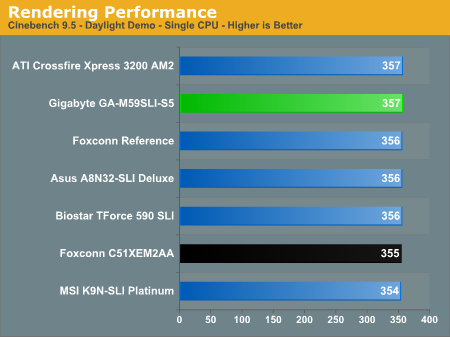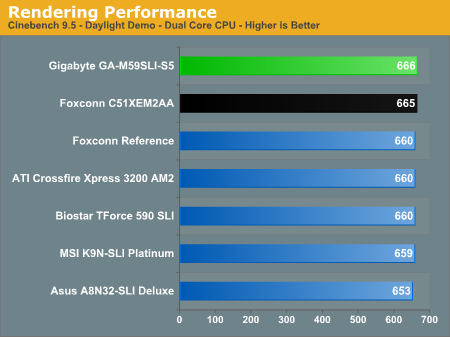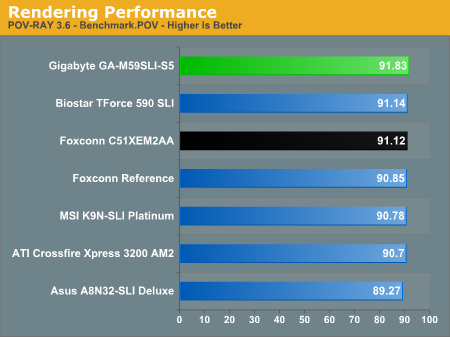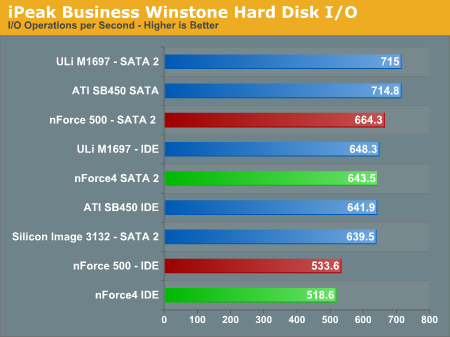Foxconn and Gigabyte Tackle Socket AM2
by Jarred Walton on June 22, 2006 1:30 AM EST- Posted in
- Motherboards
3D Rendering
We ran a couple publicly available 3D rendering applications along with our iPEAK hard disk controller performance tests. The chipset of choice can play a large role in the iPEAK scores, whereas the 3D rendering performance generally stresses the CPU more than anything else, though the memory subsystem can also play a part.



In 3D rendering, the results are all close enough that we would basically call it a tie. The difference between the fastest and slowest motherboard is less than 1%, and it's worth noting that base CPU clock speeds may be slightly higher on some motherboards -- for example, at least one board had a 200.9 MHz HTT bus when set to 200 MHz. We aren't really concerned about the minor overclock, but that also means the margin for error in terms of absolute performance is at least 1%. The end result is that 3D rendering performance is as stated a tie.
I/O Performance


There are differences in iPEAK performance, but the differences are generally confined to the chipset being used. While pure theoretical hard drive performance might be interesting to some people, in most tasks the hard drive is not the bottleneck. If you are truly concerned with hard drive performance, you should take a look at our storage reviews -- we should be adding several new articles in this area shortly.
We ran a couple publicly available 3D rendering applications along with our iPEAK hard disk controller performance tests. The chipset of choice can play a large role in the iPEAK scores, whereas the 3D rendering performance generally stresses the CPU more than anything else, though the memory subsystem can also play a part.



In 3D rendering, the results are all close enough that we would basically call it a tie. The difference between the fastest and slowest motherboard is less than 1%, and it's worth noting that base CPU clock speeds may be slightly higher on some motherboards -- for example, at least one board had a 200.9 MHz HTT bus when set to 200 MHz. We aren't really concerned about the minor overclock, but that also means the margin for error in terms of absolute performance is at least 1%. The end result is that 3D rendering performance is as stated a tie.
I/O Performance


There are differences in iPEAK performance, but the differences are generally confined to the chipset being used. While pure theoretical hard drive performance might be interesting to some people, in most tasks the hard drive is not the bottleneck. If you are truly concerned with hard drive performance, you should take a look at our storage reviews -- we should be adding several new articles in this area shortly.










36 Comments
View All Comments
archcommus - Thursday, June 22, 2006 - link
As the article conclusion mentions, I have a Epox 9NPA+ right now. Should I stick with this board and socket and just pick up a cheap X2 sometime soon instead of switching to this new platform?JarredWalton - Thursday, June 22, 2006 - link
Probably. In a month prices should be at much more reasonable levels, and while DDR2-800 with all other parts being more or less equal will be 5-10% faster, unless you're after maximum performance you're better off just upgrading your current CPU to dual core.archcommus - Friday, June 23, 2006 - link
Thanks. The only crappy part about that is having to invest in another gig of DDR memory instead of putting my money towards DDR2, but I guess if it'd last me all of next year, it's not a big deal.Myrandex - Thursday, June 22, 2006 - link
I was surprised from reading the specs list that the Foxconn has ieee1394b and the giga-byte doesn't. Traditionally Gigabyte has been the only manufacturer to consistently include this ont heir boards and it was a factor with me in the past wanting Gigabyte motherboards. Those clamp SATA connectors are nice though as the traditional ones are somewhat flimsy.Jason
R3MF - Thursday, June 22, 2006 - link
that is an absolute winner, and Gigabyte deserve praise for it.i am still waiting for a mATX 570SLI motherboard which has the same third 16x (8x) expansion slot.
preferably a fourth 1x slot as well, but i appreciate the crusties may want at least one legacy PCI slot.
glennpratt - Friday, June 23, 2006 - link
While I appreciate the thought, there is nothing but video cards and a handful of middle of the road devices that work with PCIe. Kinda sucks.MacGuffin - Thursday, June 22, 2006 - link
But something strikes me odd: Compare Page 4 of this review with Page 4 of the Biostar/MSI roundup. The HTT Overclocking Charts from the Biostar and the Foxconn are IDENTICAL (except the Memory Settings row: 9x332HTT=DDR2 665/9x332HTT=DDR 664)! Maximum CPU & Maximum FSB are the exact same!Max CPU Overclock: 258HTTx12 (3100 MHz) +29%
Max FSB Overclock: 332HTTx9 (2989 MHz) +66%
MacGuffin - Thursday, June 22, 2006 - link
Also on Page 9, right after the Splinter Cell: Chaos Theory chart,"All three of the nForce4 590 SLI"
Should be nForce 590 SLI.:-)
JarredWalton - Thursday, June 22, 2006 - link
That one I can entirely blame on Dragon NaturallySpeaking... though of course I have to blame my eyes for not catching the extra number as well.MacGuffin - Thursday, June 22, 2006 - link
Hehe...no problemo. Finish up reviews on MSI K9N Diamond, and ASUS M2N32-SLI Deluxe within 2 weeks and I won't ask for my money back ;-)